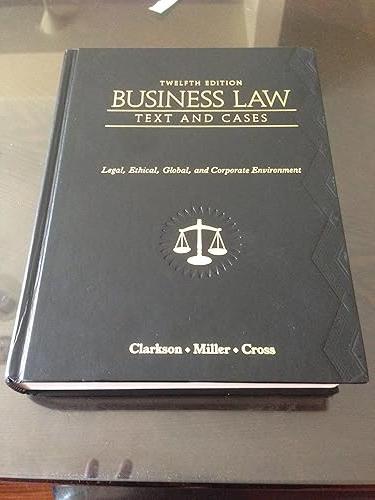Midnight Star Enterprises, L.P. (Midnight Star) is a limited partnership, which operates a gaming, on-sale liquor and
Question:
Midnight Star Enterprises, L.P. (Midnight Star) is a limited partnership, which operates a gaming, on-sale liquor and restaurant business in Deadwood, South Dakota. The owners of Midnight Star consist of: Midnight Star Enterprises, Ltd. (MSEL) as the general partner, owning 22 partnership units; Kevin Costner (Costner), owning 71.50 partnership units; and Francis and Carla Caneva (Canevas), owning 3.25 partnership units each. Costner is the sole owner of MSEL and essentially owns 93.5 partnership units.
The Canevas managed the operations of Midnight Star, receiving salaries and bonuses for their employment. According to MSEL, it became concerned about the Canevas’ management and voiced concerns. Communications between the * * * partners broke down
* * * .
MSEL * * * brought a Petition for Dissolution [in a South Dakota state court]. In order to dissolve, the fair market value of Midnight Star had to be assessed. MSEL hired Paul Thorstenson, an accountant, to determine the fair market value.
* * * The Canevas solicited an “offer” from Ken Kellar, a Deadwood casino, restaurant, and hotel owner
* * * .
* * * Thorstenson determined the fair market value was \($3.1\) million based on the hypothetical transaction standard of valuation.
* * * The * * * court * * *
found Kellar’s offer of \($6.2\) million to be the fair market value * * *
[and] ordered the majority owners to buy the business for \($6.2\) million within 10 days or the court would order the business to be sold on the open market. [MSEL appealed to the South Dakota Supreme Court.]
* * * *
[The] Canevas claim the partnership agreement does not allow the general partner to buy out their interest in Midnight Star. Instead, the Canevas argue, the agreement mandates the partnership be sold on the open market upon dissolution.
* * * Article 10.4 provides:
After all of the debts of the Partnership have been paid, the General Partner * * * may distribute in kind any Partnership property provided that a good faith effort is fi rst made to sell
* * * such property * * * at its estimated fair value to one or more third parties * * * .
* * * *
* * * This provision clearly states the General Partner “may distribute in kind any partnership property”
if the property is first offered to a third party for a fair value. While the General Partner may offer the property on the open market, Article 10.4 does not require it.
This interpretation is reinforced when read together with Article 10.3.1 * * * [which] instructs that “no assets * * * shall be sold or otherwise transferred to [any partner] unless the assets are valued at their then fair market value
* * * .” If Article 10.4 requires a forced sale, then there would be no need to have the fair market value provision of Article 10.3.1. [Emphasis added.]
* * * Read as a whole, the partnership agreement does not require a mandatory sale upon dissolution.
Instead, the general partner can opt to liquidate using either a sale or transfer under Article 10.3.1. * * *
Because MSEL decided to pursue dissolution under Article 10.3.1, we decide the correct standard for determining the fair market value of the partnership.
* * * *
MSEL claims the correct standard
* * * is the hypothetical transaction analysis * * * . [The]
Canevas argue that * * * the offer from Kellar represented the fair market value * * * .
* * * *
* * * [There are] sound policy reasons why an offer cannot be the fair market value. * * * What if a businessman, for personal reasons, offers 10 times the real value of the business? What if the partnership, for personal reasons, such as sentimental value, refuses to sell for that absurdly high offer? These arbitrary, emotional offers and rejections cannot provide a rational and reasonable basis for determining the fair market value.
[Emphasis added.]
Conversely, the hypothetical transaction standard does provide a rational and reasonable basis for determining the fair market value
* * * by removing the irrationalities, strategies, and emotions
* * * .
* * * *
Since it was error for the [lower]
court to value Midnight Star at \($6.2\) million, it was also error to force the general partners to buy the business for \($6.2\) million or sell the business.
* * * *
* * * Instead of ordering the majority partners to purchase the whole partnership for the appraised value, the majority partners should only be required to pay any interests the withdrawing partner is due.
* * * The majority partners should only be required to pay the Canevas the value of their 6.5 partnership units * * * .
* * * We reverse and remand for further proceedings * * * ..
Questions:-
1. Why did the court hold that a forced sale of the property of the limited partnership was not appropriate?
2. Under what circumstances might a forced sale of the property of a limited partnership on its dissolution be appropriate?
Step by Step Answer:

Business Law Text And Cases Legal Ethical Global And Corporate Environment
ISBN: 9780538470827
12th Edition
Authors: Kenneth W. Clarkson, Roger LeRoy Miller, Frank B. Cross





